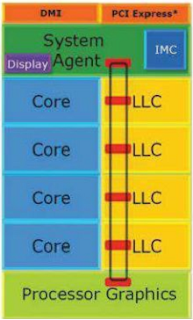For PC users on the go, machines with a long battery life are essential, but so is performance. Balancing these contradictory requirements lies at the heart of Intel’s latest CPU architecture, bearing the code name Haswell, which is expected to appear in shipping tablets, Ultrabooks, and other computers in 2013.
Intel intends to produce Haswell-based processors across a range from dual-core chips that run at less than 10 watts (suitable for tablets) to quad-core desktop CPUs that can outperform the fastest Ivy Bridge processors.
How did Intel hit its aggressive target of a 20-fold improvement in power efficiency? For the answer, we need to look at Haswell's power management technology.
The first Haswell CPUs integrate four cores. The system agent manages power.
Sleepily Active Built inside the main CPU, a special processing unit (which Intel calls the Power Control Unit) manages power almost to the transistor level. The PCU looks at which parts of the processor are idle, and it turns individual parts on and off as they’re needed.
 |
| How Intel’s Haswell processors CPU Manages PC Power |
Haswell’s solution is to add a third power state—which Intel’s designers call Active Idle (aka SOix)—a very low-power active state that uses one-twentieth the power that Ivy Bridge uses. The PC considers itself awake, but the CPU is mostly asleep. This trick translates into wake times of no more than a few tenths of a second. From the user's perspective, this is considerably better than the several seconds that today's CPUs take to wake up. Haswell is almost always in this "instant resume" state while running.
0 comments:
Post a Comment